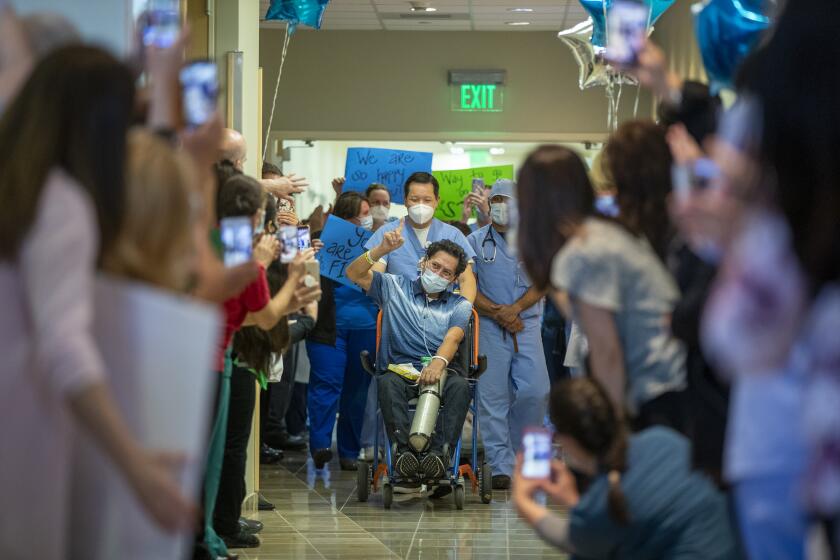Big cities like L.A. might be slower to reopen than suburbs and smaller communities

- Share via
Gov. Gavin Newsom’s latest plans for easing stay-at-home restrictions will potentially allow some parts of California to reopen at a faster rate than others if they can show the coronavirus has eased as a public health threat.
Newsom announced Monday that some retail stores across the state can reopen with modifications as early as Friday amid growing pressure to ease the stay-at-home order that has cratered the California economy.
But the virus is a bigger problem in some parts of California than others. L.A. County continues to be a hotbed of the crisis, with more than 1,250 deaths linked to COVID-19. The county accounts for nearly half of all hospitalizations in the state.
Conversely, the number of infections in some rural and suburban counties is dramatically lower, four counties have seen no cases at all, and more than a dozen counties have reported no deaths from the illness.
These are some of the unusual new scenes across the Southland during the coronavirus outbreak.
At least three counties — Modoc, near the Oregon border, and Yuba and Sutter, north of Sacramento — have reopened with restrictions in defiance of Newsom’s order, and more than a dozen other communities have requested the power to follow suit.
Politically, there have also been divides. Officials in Los Angeles and the Bay Area have been more cautious, saying they fear reopening too early could cause further outbreaks and hurt the economy in the long run.
L.A. Mayor Eric Garcetti said Monday that different cities would need to take different steps to emerge from the pandemic-induced shutdown and that city and county officials were still trying to determine the safest course.
“Our timing on opening may vary from other parts of the state,” he said. “I will reopen our city with careful consideration, guided by public health professionals.”
Garcetti said he did not expect city businesses to be able to offer curbside delivery on Friday in step with Newsom’s outline. L.A.’s Safer at Home order is in effect until May 15, and Garcetti said that he hoped steps restricting commerce could begin to be rolled back by then.
California’s rural areas are in revolt against Gov. Gavin Newsom’s statewide coronavirus rules, which make little sense in burgs such as Bieber.
Los Angeles County Public Health director Barbara Ferrer said Monday that officials would be publicly sharing recovery plans this week, noting that “wherever it’s possible to safely reopen, we’ll be doing so as quickly as possible.”
On Monday, San Francisco Mayor London Breed said she could not say when city businesses covered by Newsom’s order would reopen, saying safety is the top priority.
“I think it’s important that we provide some guidance. To be clear, the whole point of the health directive has everything to do with limiting our ability to be in contact with people so we can avoid not only transmitting the virus or contracting the virus,” Breed told reporters. “The ability to do that is critical, but we also realize there are a number of people out there who are struggling financially, and if there is a way to accomplish the public health goals of keeping people safe with also allowing businesses to operate, but operate differently with certain guidelines.”
The governor’s plan also expands decision-making at the local level, allowing some communities to move further ahead into the second phase of the reopening process at their own pace and open more businesses — such as restaurant dining rooms — beyond those outlined in the statewide policy.
But if communities want to take that next step, counties must first submit “containment plans” that meet certain requirements for hospital beds, testing kits, and the ability to track infected people and trace their contacts, Newsom said. Other local orders that are more restrictive than statewide reopening plans would supersede any changes the governor makes.
A mutation in the novel coronavirus has led to a new strain viewed as more contagious than the virus that emerged from China, according to a new study.
The Democratic governor’s move to give more discretion to counties follows large protests against Newsom’s restrictions at the state Capitol and in Orange County, and as a handful of small rural counties moved to open their communities in defiance of his authority.
On Monday, Riverside Mayor Rusty Bailey and 2nd District Supervisor Karen Spiegel argued that the county’s orders had made it possible to contain the spread of the virus and prevent a hospital surge that was expected in mid-April. But now, they want to focus on the county’s economic future.
“The metrics in Riverside County have improved,” Spiegel said at a news conference. “That was due to the extra measures that the county put in place early on. We were one of the first that stepped up and said we’re going to fight this battle. The positive results would not have been possible if the community didn’t do their part and step up.”
Bailey said he thought the county was ready for the second stage of Newsom’s four-stage plan, which includes the opening of low-risk workplaces such as retail and manufacturing. He said the Inland Empire was also ready to open recreation facilities and religious institutions.
“Our region desires to be on our toes, not on our heels, at the front of the pack when the governor gives us the green light,” Bailey said. “We are eagerly awaiting for the go-ahead to restart Riverside’s regional economy.”
Which California businesses can reopen this week?
At least three Northern California counties have defied Newsom’s orders, allowing businesses to reopen beyond the statewide order. Newsom declined to say Monday whether there would be consequences for those counties and said the overwhelming majority of the state’s 58 counties were doing the right thing.
The revised Yuba-Sutter counties’ order allows restaurants, retailers, shopping malls, gyms, salons, spas and tattoo parlors to operate once more “as long as appropriate business modifications are made to adhere to social distancing and other tenets of combating COVID-19,” according to a statement.
Those measures include regularly washing hands, staying home when sick and wearing a facial covering when social distancing isn’t possible, according to public heath officer Phuong Luu.
Many businesses remain closed, even under the counties’ revised order, including bars and nightclubs that don’t serve food, museums, movie theaters, bowling alleys, arcades, live performance venues, places of worship and other mass gathering spaces, schools, community centers, beaches and piers, and summer camps and residence halls.
Marni Sanders, chief executive of the Yuba-Sutter Chamber of Commerce, says the local business community “is thrilled that we are open.”
“I can tell you driving around there are lots of businesses open that weren’t open yesterday, so it’s a really good sign,” she said Monday.
Over the past few weeks, Sanders said, there “was a lot of frustration and anxiety,” but the community “is very optimistic and has remained hopeful throughout this whole pandemic situation.”
“We want to encourage people to shop and to dine and to get out there into our businesses and get money pumping into our economy, but we also are reminding people to be safe,” she said. “And our businesses are being safe as well during this phased reopening.”
Among the establishments that took advantage of the revised health order was Lumberjacks Restaurant in Yuba City, which announced it would welcome diners back with restrictions, including “constant sanitation, significantly reduced capacity, limited contact with customers, and more,” according to a Facebook post.
“We understand some of you do not feel comfortable returning to dining rooms just yet,” the post continued, “which is why we will be continuing our takeout and delivery options the same as we have been for the last few weeks.”
More to Read
Sign up for Essential California
The most important California stories and recommendations in your inbox every morning.
You may occasionally receive promotional content from the Los Angeles Times.


















